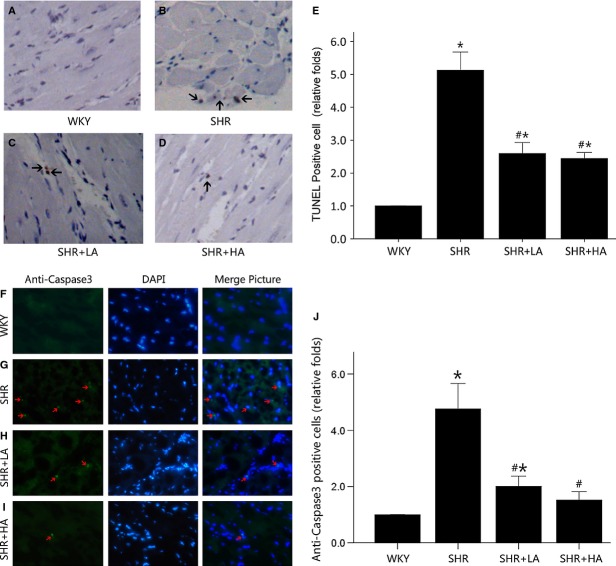Fig. 1.
Cardiomyocyte apoptosis detected by TUNEL assay and Immunofluorescent labelling for active caspase-3. (A) No TUNEL-positive cardiomyocyte in the representative TUNEL staining of WKY controls; (B) multiple TUNEL-positive cardiomyocyte in the representative TUNEL staining of SHR controls compared with WKY controls (P < 0.01); (C and D) less TUNEL-positive cardiomyocyte in SHR+LA and SHR+HA (P < 0.01); (E) quantitative analysis of TUNEL-positive cardiomyocytes in the four groups by the ratio of TUNEL-positive cell number to the total and normalized to the WKY controls. (F) Few active caspase-3-positive cardiomyocytes in the representative immunofluorescent staining of WKY controls; (G) multiple active caspase-3-positive cardiomyocytes in the representative immunofluorescent staining of SHR controls compared with WKY controls (P < 0.05); (H and I) less active caspase-3-positive cardiomyocytes in SHR+LA and SHR+HA (P < 0.05); (J) quantitative analysis of active caspase-3-positive cardiomyocytes in the four groups by the ratio of active caspase-3-positive number to the total and normalized to the WKY controls. Values, mean ± SEM; n = 4; *P < 0.01 versus WKY controls; #P < 0.01 versus SHR controls; arrow indicating a TUNEL-positive cardiomyocytes or a caspase-3-positive cardiomyocyte; WKY: Wistar; SHR: spontaneously hypertensive rats; LA: low dose of Aliskiren; HA: high dose of Aliskiren.

